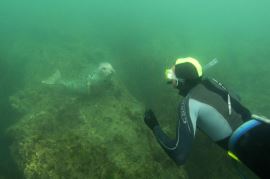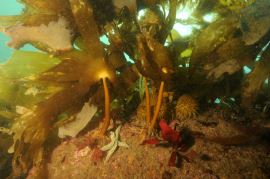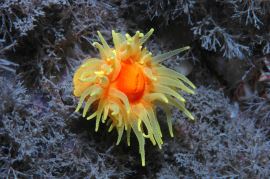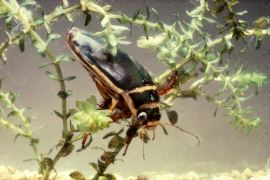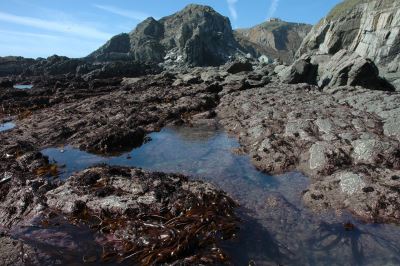 Lundy has been a popular destination for marine naturalists since the middle of the 19th century. The shores were especially thoroughly surveyed by Leslie and Clare Harvey in the late 1940s but discovering its underwater treasures awaited the advent of scuba diving in the late 1960s.
Lundy has been a popular destination for marine naturalists since the middle of the 19th century. The shores were especially thoroughly surveyed by Leslie and Clare Harvey in the late 1940s but discovering its underwater treasures awaited the advent of scuba diving in the late 1960s.
The shores are almost entirely rock and are very varied in character; from those exposed to extremely strong wave action to those of the much more sheltered Landing Bay. Most are inaccessible except by boat but the Landing Bay and the area south of Rat Island known as ‘Devil’s Kitchen’ are easily visited. Here the visitor can find a rich variety of seaweeds especially in rockpools and highlights such as the Snakelocks and Strawberry Anemones. Spend some time looking into rockpools – there are darting fish and cushion stars to see. On the lowest tides, under overhangs and in pools, the lucky visitor may find a Lundy speciality – the nationally scarce Scarlet and Gold Star Coral as well as jewel anemones and pendulous colonies of sea squirts.
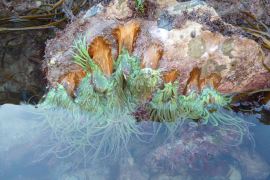
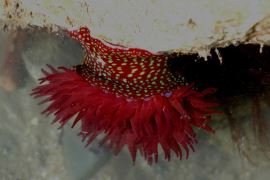
 It was in the early 1970s that the richness of Lundy’s underwater life revealed itself to marine biologists diving around the island. The underwater topography is rugged with steep rock slopes, overhangs and canyons. Lundy hosts all five species of shallow water stony corals found around Britain as well as colourful sponges, soft corals and sea fans.
It was in the early 1970s that the richness of Lundy’s underwater life revealed itself to marine biologists diving around the island. The underwater topography is rugged with steep rock slopes, overhangs and canyons. Lundy hosts all five species of shallow water stony corals found around Britain as well as colourful sponges, soft corals and sea fans.
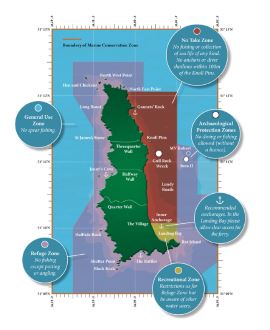 Since the establishment of a no-take zone off the east coast, European (blue) Lobsters have thrived there and, now that the taking of endangered Spiny Lobsters is banned all around Lundy, those able to venture beneath the waves are likely to see this charismatic species. The island's waters are a playground for seals (see the section on mammals) and many divers come to Lundy specifically to spend time with them.
Since the establishment of a no-take zone off the east coast, European (blue) Lobsters have thrived there and, now that the taking of endangered Spiny Lobsters is banned all around Lundy, those able to venture beneath the waves are likely to see this charismatic species. The island's waters are a playground for seals (see the section on mammals) and many divers come to Lundy specifically to spend time with them.
You can see more by snorkelling, especially fish and seals in amongst the kelp forest. But, do be careful not to venture into the areas where there are strong currents.
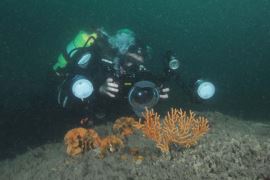

Much of what we know about marine ecology has been established from research undertaken at Lundy. There is still much to learn and your observations, recorded in the LFS logbook in the Tavern, could help us better understand what is where and when it is there.
Text by Keith Hiscock
 Water levels in the ponds and streams on Lundy are governed by rainfall with several drying up during periods of drought and many temporary water bodies appearing during periods of intense rainfall. Their acidic water chemistry relates to the geology of the island which is mainly composed of Tertiary granite.
Water levels in the ponds and streams on Lundy are governed by rainfall with several drying up during periods of drought and many temporary water bodies appearing during periods of intense rainfall. Their acidic water chemistry relates to the geology of the island which is mainly composed of Tertiary granite.
The largest body of water on the island is Pondsbury which is surrounded by Sphagnum bog, heathland and rough pasture. Other ponds of reasonable size are mainly artificial, being formed from flooding of quarry workings and rock depressions. They can be found near the Rocket Pole, Quarterwall, Old Quarry, Widows Tenement and on Acklands Moor.
The flora and fauna of the ponds and streams are mainly typical of acidic waters on the mainland and there appear to be no endemic species in them.
Some of the ponds contain fish, mainly carp,that were introduced by a previous island owner in the late 1920s. Mirror Carp can still be found in the Rocket Pole Pond, Golden and Mirror Carp in Old Quarry Pond and Crucian Carp in Pondsbury.
Flora
The larger ponds have species of Rush at their edges. Bog Pondweed, Marsh Pennywort and Water Forget-me-not also occur in most of the ponds.
Plankton
 Unicellular green algae e.g. Pediastrum, can be found in the plankton of several of the ponds, and a blue-green alga, Microcystis, appears at certain times of the year. Frequent algal blooms occur in Rocket Pole Pond. Water fleas, Daphnia obtusa and Chydorus sphaericus and the Copepod Cyclops can be found during most months of the year. Rotifers are represented by species of Keratella, Brachionus and Filinia in the larger ponds.
Unicellular green algae e.g. Pediastrum, can be found in the plankton of several of the ponds, and a blue-green alga, Microcystis, appears at certain times of the year. Frequent algal blooms occur in Rocket Pole Pond. Water fleas, Daphnia obtusa and Chydorus sphaericus and the Copepod Cyclops can be found during most months of the year. Rotifers are represented by species of Keratella, Brachionus and Filinia in the larger ponds.
Macroinvertebrates
The ponds, particularly the larger Pondsbury, have a good diversity of macroinvertebrates. The water slater Proasellus meridianus that is common on offshore islands, is a dominant member in most of the ponds but is not usually found on mainland UK. A flatworm Polycelis nigra and a leech Helobdella stagnalis occur in nearly all of the larger ponds.
The Horse Leech Haemopis sanguisuga can also be found in Lundy freshwaters. Insects, both adults and larvae, are the most diverse group, with water bugs (Hemiptera) and water beetles (Coleoptera) well-represented. Water boatmen, the smaller Corixids and the larger Notonectids and the Dytiscid diving beetles are frequently found. Other notable forms include the larva of the May fly Cloeon dipterum, the Blue-tailed Damselfly Ischnura elegans, the Common Darter dragonfly Sympetrum striolatum, the caddisfly Limnephilus vittatus and Chironomid midge larva. Few molluscs occur in the acidic Lundy ponds.
Streams
Lundy streams, apart from the stream running down St John’s Valley, are often dry and consequently have an impoverished flora and fauna when compared with those on the mainland. Bryophyte flora have been found in all six of the west and east coast streams. Amongst the macroinvertebrates, the Chironomid midge and the Polycentropid net-spinning caddis larva, frequently occur. Unlike in the ponds, molluscs are well represented with Potamopyrgus antipodarum, the Jenkins' Spire Snail, abundant in St John’s Stream and in the Pyramid Stream on the west side of the island.
Monitoring of Lundy’s freshwater habitats has shown that the ponds and streams do show differences in their flora and fauna and that these differences can be related to their position on the island and hence exposure to the elements, water chemistry, vegetation cover, amount of decaying material in the ponds and the occurrence of algal blooms. An important environmental factor affecting the freshwater life is the drying up of the habitat. Many organisms can survive by encystment or having resistant eggs and temporary pools quickly become recolonized when water returns.
Main surveys of the freshwaters began in the 1970s and the flora and fauna have shown remarkable stability over the last 40 or so years. Research papers on the freshwater life can be found in the LFS Annual Reports and in the more recent LFS Journal, and are listed in the bibliography.
Text by Jennifer George
Lundy boasts immaculate granite cliffs up to 120m in height providing a wealth of sea cliff adventures amongst stunning scenery and wildlife and over 1000 routes are documented. To avoid disturbance to nesting seabirds, access restrictions that cover around 70% of the cliffs are typically put in place between 31 March and 14 August, although these may be extended or varied depending on the breeding season. A small number of crags and buttresses are closed until 15 September to avoid disturbance to breeding Fulmar. The 2021 information, published by The Landmark Trust, can be found here. Climbers are advised to check the noticeboard in the Marisco Tavern and contact the Warden in advanmce or on arrival.
The majority of Lundy's cliffs are on the western side of the island, with the most popular cliffs between Old Light and Three-quarter Wall. When high winds or big seas make climbing on the west coast impossible, there are good climbs on Halfway Buttress on the east, around the obvious Logan Stone.
The definitive guide, by Paul Harrison, published in 2008 is available from The Climbers Club website, where there are also free downloads of a 2017 update and a 2009 supplement covering the Knight Templar Rocks.
According to UKClimbing, the most popular climbs are:
- The Devil's Slide (HS 4a) - the classic Lundy slab climb, not usually affected by the seabird restrictions; 117m, 5 pitches, although pitches 1+2 and 4+5 may be combined.
- Albion (VS 4c) - a popular climb in the Devil's Slide area - the big corner on the left-hand side of the Devil's Slide; 107m, 4 pitches.
- Satan's Slip (E1 5a) - also in the Devil's Slide area follows the black streak up the left hand side of the Devil's Slide until it reaches the corner of Albion higher up; 3 pitches.
- Diamond Solitaire (VS 4c) - in the Flying Buttress area, near Battery Point, 2 pitches.
- Horseman's Route (HS 4b) - in the same area as Diamond Solitaire; 2 pitches.
- The Indy 500 (E1 5b) - in the Landing Craft Bay area, south of Battery Point; 35m, 1 pitch.
- Shamrock (VS 4c) - also in the Landing Craft Bay area; 3 pitches.
- Double Diamond (HVS 5b) - in the Flying Buttress area; 35m, 1 pitch.
- Formula One (HVS 5a) - adjacent to Indy 500 in the Landing Craft Bay area, formerly one of Lundy's classic HVSs and a route of great variety; 40m, 1 pitch. The top flake had fallen away by June 2012, with loose rock forcing an escape onto the Indy 500 route (the so-called 'Formula 500' variant).
Over 350 species of lichens have been recorded on Lundy, which is about one-fifth of the total lichen flora of Great Britain, making Lundy a very important site. The clean air, south-western oceanic location, variety of undisturbed habitats and lack of agricultural or industrial contaminants provide ideal conditions for these symbiotic organisms. A lichen is a partnership between a fungus and an alga and can assume a diverse range of forms. The fungus provides the structure and absorbs moisture and the alga provides the food by photosynthesising. Lichens are very slow growing and can colonise a wide range of substrates. On Lundy they can be found from the intertidal zone to the top of the island, on natural rocks, walls, woody and herbaceous plants, exposed peat and sometimes on metal and other man-made surfaces. Lichens reproduce by means of microscopic spores which develop in “fruiting bodies” on the surface of mature specimens. The use of a hand lens will help in observing these structures.
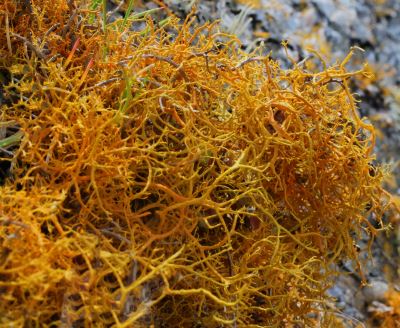 A noticeable feature of the rocks at sea level is the zonation of lichens just above the high tide line. Bands of black, orange and grey lichens can be easily seen from a distance. Higher up above the high tide line and splash zone some of the largest lichens can be found, including the grey-green Sea Ivory Ramalina siliquosa which produces long flowing strands in exposed sites and may cover whole outcrops. One other noticeable feature of exposed outcrops is the Golden Hair Lichen Teloschistes flavicans, a nationally very rare and fully protected species which thrives on Lundy.
A noticeable feature of the rocks at sea level is the zonation of lichens just above the high tide line. Bands of black, orange and grey lichens can be easily seen from a distance. Higher up above the high tide line and splash zone some of the largest lichens can be found, including the grey-green Sea Ivory Ramalina siliquosa which produces long flowing strands in exposed sites and may cover whole outcrops. One other noticeable feature of exposed outcrops is the Golden Hair Lichen Teloschistes flavicans, a nationally very rare and fully protected species which thrives on Lundy.
The maritime heathland on top of the island is another good habitat for lichens with several species of “Reindeer Moss” such as Cladonia ciliata var tenuis and C. portentosa being quite widespread. Little spots of bright red are sometimes noticed amongst the grey tufts and these are the tips of the fruiting bodies of Bengal Matchsticks Cladonia floerkeana.
Towards the north end of the island are some noticeable exposures of granite which are gradually being re-colonised after disastrous peat fires in 1933 and 1935 when most of the organic matter was burnt off. Lichens are the first colonisers of these habitats and provide a good example of the recovery of a site after serious damage to the environment.
The granite marker stones, in position along the main track since 1909, provide good habitats for lichens, especially species which thrive where there is some nutrient enrichment, such as from bird droppings. The bright orange Xanthoria candelaria is one species which thrives here, but closer examination will reveal many more species, including the brownish foliose Anaptychia runcinata.
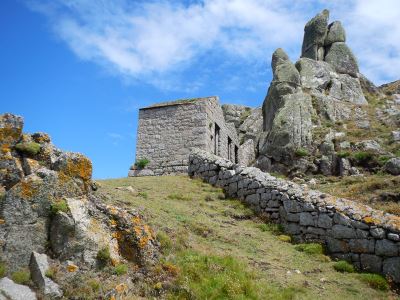 Lundy has many stone walls, almost all made of the island’s granite, and these provide ideal habitats for lichens. Different communities can be found on opposite sides of some of the walls, with some requiring shade and others growing well in full sunlight. As many as 50 species can be found on the south-facing side of Halfway Wall, but the north-facing side has a smaller range of species and fewer individuals.
Lundy has many stone walls, almost all made of the island’s granite, and these provide ideal habitats for lichens. Different communities can be found on opposite sides of some of the walls, with some requiring shade and others growing well in full sunlight. As many as 50 species can be found on the south-facing side of Halfway Wall, but the north-facing side has a smaller range of species and fewer individuals.
The cemetery at Beacon Hill provides more habitats for lichens in the form of headstones and memorials, some made of the local granite, but some made from imported rocks such as slate and marble which support different lichen communities.
Trees are scarce on Lundy, and are mostly found on the sheltered east side of the island, but despite the paucity of trees about 120 species of lichens have been found colonising them. Many of the lichens on trees are quite large foliose species which completely cover the twigs and branches they are growing on. There are various species of Usnea which are seen as indicator species of very clean air. Some lichens are host-specific, so a species which grows on Beech, may not also occur on Oak. Oak Moss Evernia prunastri, however, seems to be most at home on Blackthorn.
More information can be found in Lundy Lichens by Ann Allen, published in 2007 by the Lundy Field Society.
Text by Andrew Cleave
There are no articles in this category. If subcategories display on this page, they may have articles.
Latest news
Diana Keast

It is with huge sadness that we share news of the death of our President, Diana Keast, who passed away peacefully last night.
Diana was the last surviving private owner of Lundy. Her father, Martin Coles Harman, purchased Lundy in 1925 and following his death Martin's surviving children inherited Lundy. It was Diana, with her sister Ruth and sister-in-law Kay, who sold Lundy to the National Trust in 1969.
Online 2021 AGM
Our 2021 AGM will take place online on Saturday 4th September from 3.30pm prompt using Zoom. We look forward to seeing you for a short business meeting followed by the Warden's Report, presented by Dean Jones, and the Lundy General Manager's Report, presented by Derek Green.
Lundy featured on BBC Travel website
An item entitled Lundy:The tiny isle with a wild, lawless past was posted today on the BBC Hidden Britain website. You an read the article here.
Subcategories
